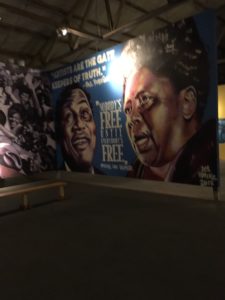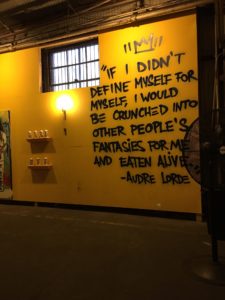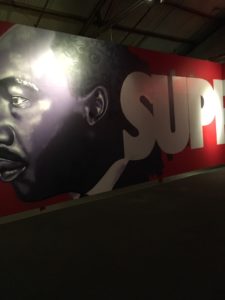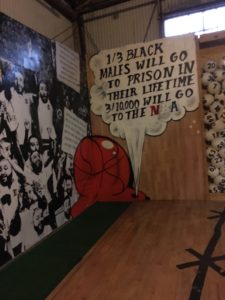I chatted with Brandan “B-mike” Odums via e-mail a few years earlier for an article I was writing for Scalawag Magazine, but since then his work has become even more well known, if that is possible: he already had a large following in and out of New Orleans for his street art and larger than life paintings informed by African American history, but since one of his pieces was featured on OWN’s Queen Sugar, his popularity has soared. While I had seen some of B-mike’s murals around the city, I had never been to Studio Be, the cavernous warehouse in the Bywater neighborhood, filled to the brim with enormous paintings, many nearly reaching the ceiling.
My visit was for fun and for research: I am interested in the ways artists have engaged in prisoner rights activism and B-mike’s work has an incredibly political tone: he painted a mural of Angola 3 member Albert Woodfox and the quotes and images of African American writers and activists feature heavily in his work.
His studio features quotes from people like Audre Lorde and Muhammad Ali. It features huge paintings of MLK, Fred Hampton, and other prominent figures in African American history. It struck me as I walked through that, though his art certainly has an activist bent, he was also making a historical intervention. He framed African American activists as heroes, connected the struggle of Eric Garner and Trayvon Martin to that of Martin Luther King Jr and centered books as source material and inspiration. He featured the words of Black Panther Party members alongside the words
of prominent intersectional scholars. B-mike’s work was engaging with the theoretical and political work of these African American activists and attempting to educate visitors, particularly children, who might be unfamiliar with this history.
In the gift shop of Bestudio one can buy the usual: t-shirts, prints, tote bags, and other souvenirs with prints of his artwork on them. B-mike doesn’t throw away his paint cans, but instead paints them with images of African American activists, writers, and artists. I couldn’t afford the real thing, but I did pick up a printed can of Fred Hampton on my way out. The store also featured a selection of books B-mike deemed important: Revolutionary Suicide by Huey Newton, The New Jim Crow by Michelle Alexander, a few works by James Baldwin, and other works in radical African American history.
Bmike intentionally drew connections between very well known African American leaders like MLK to the Black Lives Matter movement and mass incarceration. He emphasized the importance of lesser known activists like Fred Hampton. B-mike didn’t entertain differences between “violent” and “non-violent” activism, acceptable and unacceptable history, but emphasized the shared intellectual and artistic lineage of his work.
I don’t usually write about street artists in this space, but like many of my posts, I think Bmike’s work should make us think about the boundaries we have drawn around professional history. B-mike might not be a professional historian in any traditional sense, but his work is fighting “alternative facts,” engaging in theoretical discussions, and giving access to important radical and intellectual arguments in spaces and to people who might not be exposed to historical monographs, or even the Washington Post’s wonderful Made by History series.





14 Thoughts on this Post
S-USIH Comment Policy
We ask that those who participate in the discussions generated in the Comments section do so with the same decorum as they would in any other academic setting or context. Since the USIH bloggers write under our real names, we would prefer that our commenters also identify themselves by their real name. As our primary goal is to stimulate and engage in fruitful and productive discussion, ad hominem attacks (personal or professional), unnecessary insults, and/or mean-spiritedness have no place in the USIH Blog’s Comments section. Therefore, we reserve the right to remove any comments that contain any of the above and/or are not intended to further the discussion of the topic of the post. We welcome suggestions for corrections to any of our posts. As the official blog of the Society of US Intellectual History, we hope to foster a diverse community of scholars and readers who engage with one another in discussions of US intellectual history, broadly understood.
Holly, thank you for this delightful “gallery tour.” And thanks also for this reminder of the breadth of sources from which we can draw to do intellectual history, and for how we can think about the ideational valences of a primarily visual medium.
Of course! Glad you liked it-was a little nervous about posting it here!
I just wanted to add to what L.D. stated above. This is a good example of the kind of sources traditional intellectual history has ignored over the years, but should no longer do so. Your essay also reminds me of the long tradition among African Americans (among many groups in American history) of crafting their own historical and cultural narratives in their own spaces. Great work.
Absolutely important point about the long tradition of created spaces! And I thought of you as soon as I stepped in there-you would LOVE it.
I love your conclusion, Holly, especially the last line: “B-mike might not be a professional historian in any traditional sense, but his work is fighting “alternative facts,” engaging in theoretical discussions, and giving access to important radical and intellectual arguments in spaces and to people who might not be exposed to historical monographs, or even the Washington Post’s wonderful Made by History series.”
I also love the idea of Bmike’s studio as a bookstore—disseminating text with a provocative context.
Thanks! The bookstore was super interesting-especially considering how many academic (or academic adjacent) books were for sale in it!
I’m sitting here wondering if our relationship with or reaction to art is/can be solely analytical (understanding) or if it is something of a vastly different order or nature (communication/creation of emotion) as well as when does something cross the line from art to journalism or vice versa?
I definitely agree that our relationship to art is never solely analytical, but I think that goes for a lot of more stereotypically analytical mediums as well.
And I am not quite sure what you mean about the distinction between art and journalism. Can’t something be both?
journalism can be explained; art can be understood.
journalism is about knowledge; art is about wisdom.
I think these are two pretty good ways of looking at these two things. I don’t think something can be both because the two are mutually exclusive.
“Stereotypical mediums”? not sure what you mean
I think the difficulty historians have with using art as a source is that each person’s response is different from all others. there are just too many to include. what happens then is that broad labels such as romanticism, metaphysical, realism, etc., are coined, applied and defined. still they don’t begin to touch the reality as others experience it. explications just don’t do the job. everything except thee experience itself is inadequate.
hope this clears things us some if not let me know and i’ll give it another go.
I guess I just don’t agree with the premise that journalism is wholly analytical or about knowledge (I would argue that some very good journalism is art etc). I also think this discounts the ability of journalism to make us feel. What’s more, even if something is more analytical than emotional, each persons response will be varied. This isn’t unique to art. And i don’t think the two are mutually exclusive: can’t art do journalistic work? Can’t good journalism be art? How do we separate journalism from artistic forms of writing? I think these aren’t all concrete distinctions.
journalism is reportage of fact and uses nouns and verbs for the most part. it is quantitative. there is an art of journalism but it is not art itself.
comapre with a novel, for example.
what “good journalism” would you say is art?
i believe the two to be mutually exclusive
how do we spare them? your heart or your will tell you.
you might ant to read t.s. eliot’s essay on the metaphysical poets for a start.
I think the over reliance on a kind of enlightenment conception of “fact” is part of the problem-I don’t think Journalism relies on fact any more than art does. And I think that much of the journalism post Katrina (in New Orleans right now) was very artistic, but also much literary reportage etc. I think journalism and novels have very much in common and we simply see these mediums in different lights.
Journalism can make one feel and can be art: I think many journalists would agree.
Journalism can rise to an art form and thus there are porous boundaries between it (cf. ‘gonzo’ and the ‘new’ journalism) and the different kinds of literature and there are many works by journalists replete with artistic virtues common to the best literature (short stories, novels, plays, poems …). Some writers, like Norman Mailer, also practiced journalism and there were artistic qualities exemplified in both forms of writing. It’s not an incidental fact that Charles Dickens was first an accomplished journalist before he became known as a writer and Joyce Carol Oates is both an author and a journalist (her artistic talents as a writer spillover into her work as a journalist). It would be hard to deny that at least some of the artistic merits of her various literary works are evidenced in her journalistic productions. As it would be too tedious to cite the many instances where the writing of journalism rises to a literary art form, I’ll simply mention a few folks whose journalism often reaches the heights we ascribe to (‘good’) art: James Baldwin, Ernest Hemingway, Joan Didion, Jimmy Breslin, W.E.B. Du Bois, Frances Fitzgerald …. Holly is right: good journalism can be accorded the approbative appellation, “art.”
Not only, as is said above, can journalism on occasion (or quite a few occasions) rise to an art form, but the notion that “art is about wisdom” (Andrew Parker) and not “knowledge” is also somewhat problematic. Yes, great art or even good art often conveys wisdom, but art can also convey knowledge, if not necessarily in the sense of unadorned empirical fact then certainly in the sense of giving one a feeling for an era or a period and for how people lived. That goes for painting, street art, and definitely novels — I could get into specific examples but would take too much time (and there are too many to choose from).
That there are entire programs of study combining history and literature is some evidence in itself that rigid, airtight separations between the realm of facts and their interpretation, on the one hand, and the realm of art on the other, are misguided. That’s not to say one can’t draw distinctions, but if you set out to understand, say, Victorian Britain, and then decide you aren’t going to read any 19th-century English novels because novels don’t furnish “knowledge,” you’re making a mistake.